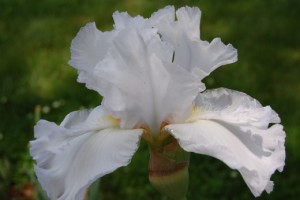 About ten years ago, a friend gave me a single large iris rhizome division. It was from a tall, bearded type that grew in carefree splendor in her western New York garden. I planted it in the free-draining soil at our family’s summer cottage in Central New York and it grew, or maybe “grew” is the wrong word. “Exploded” might be better. Ten years later, we have the offspring of that one iris division everywhere. I divided the original after the first year and I have divided the original divisions many times in the last decade. I just divided an overgrown clump that was overdue for the treatment and had expanded to about two feet in diameter. That operation yielded about twenty new plants and I was hard-pressed to know where to put them all. Fortunately, I have space in my home garden, not to mention iris-loving friends who will take some of those garden orphans off my hands.
About ten years ago, a friend gave me a single large iris rhizome division. It was from a tall, bearded type that grew in carefree splendor in her western New York garden. I planted it in the free-draining soil at our family’s summer cottage in Central New York and it grew, or maybe “grew” is the wrong word. “Exploded” might be better. Ten years later, we have the offspring of that one iris division everywhere. I divided the original after the first year and I have divided the original divisions many times in the last decade. I just divided an overgrown clump that was overdue for the treatment and had expanded to about two feet in diameter. That operation yielded about twenty new plants and I was hard-pressed to know where to put them all. Fortunately, I have space in my home garden, not to mention iris-loving friends who will take some of those garden orphans off my hands.
If my prolific white iris was a little less beautiful, this would not be much of a problem. But it is gorgeous. I have no idea of its varietal name, but I think it is relatively old-fashioned, because the flower stalks are not as tall as some of the modern varieties. The plants never need staking and the flowers are also lightly fragrant. In the cold light of day, both the “falls–downward pointed petals—and the standards—upward-facing petals–look white. When the light is more diffuse, the blooms look very pale blue—as if someone splashed a drop of blue paint in a gallon of white.
Because we are blessed with such iris abundance, I have planted them everywhere around our summer cottage. On the beach they stand above the water and look like something painted by Monet. Next to the cottage, they complement the gray shingles. In the little bed that we installed around the stump of a long-felled cottonwood tree, the leaves provide texture even when the plant is out of bloom. In short, the white iris succeed everywhere.
Over the years, I have grown many bearded iris varieties, including a lovely specimen with pale blue standards and pale peach falls. Those iris have multiplied in a well-mannered way and I have divided them as necessary. I don’t think I have ever lost one, despite harsh winters, monsoon springs and torrid summers. However, I have never had an iris perform like my summer house iris. The neighboring houses and cottages don’t seem inundated with iris of any kind, but maybe that is because they don’t have my white one—yet.
I have treated the summer house iris the same way I treat all of its kin. The rhizomes go into the ground with the shallowest covering of soil—about one inch. On clay soil, which I have in my garden, I add fine gravel to the planting mix to ease the drainage. The great enemy of bearded iris is wet feet, which promotes rhizome rot. Iris borers are another common problem, tunneling into rhizomes and destroying them. To outwit the borers, divide iris every few years and check for signs of borers. Discard any soft or damaged rhizomes.
I have never met anyone with iris as prolific as my summer house specials, but I have often come across overgrown clumps. Generally in an overgrown situation, the plants sprout in a ring formation around a non-productive center area. This center is made up of the old, dead rhizomes. To revive your iris, lift the entire ring, which is easy because the roots are shallow. Take a garden knife or other sharp instrument and lop off all the non-productive rhizomes. Save those outer pieces that have fans of leaves attached. Replant them, positioning some in the original location and parceling out the others. Don’t be afraid that you will kill the divisions. Iris look delicate, but they are really very tough.
Modern bearded iris, including the summer house iris, are descended from Iris germanica or German iris. They are one of those “grandmother’s garden” species that remind people of earlier generations of gardeners. Not far from our summer property, in a place where the forest has almost engulfed an ancient farmhouse, a stand of bearded iris survives in a clearing. It was probably planted by some farmer or his wife. I doubt that it is as prolific as my white-flowered beauty, but I have no doubt that it is equally sturdy.
